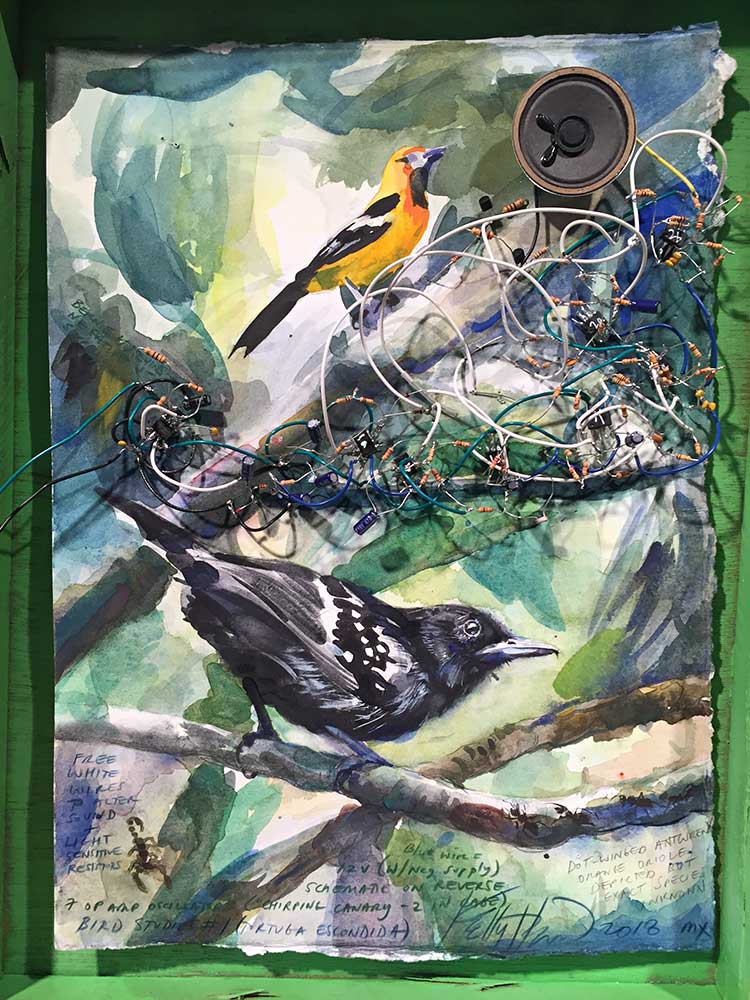I've been remiss in my project documentation since returning from Mexico's Yucatan peninsula (and end-of-year distractions).
This post covers the bird studies that I built during my time at Tortuga Escondida near Akumal, Mexico. For my residency, I took a miniature version of my electronics workbench with me for five weeks of study in the jungle, where hacking supplies are not only unavailable but subject to failure due to fluctuating voltages, high humidity, sporadic connectivity, jungle wildlife, and mischievous Mayan spirits called "Aluxes." Electricity really is different in the rural Yucatan than most modernized parts of the United States. It was a fascinating albeit frustrating experience to build delicate circuits in such an uncertain environment, especially after my oscilloscope died from any number of mysterious causes. I'm not complaining, though -- it was one of the most memorable experiences of my life and gave me new appreciation for the complex relationships between electricity, nature, and culture. When I left, I donated my electronic supplies to the Akumal community center, hopefully inspiring some intrepid hackers in the pueblo. I plan to return.
Back to my birds. I brought with me several printed schematics and data sheets as a point of departure, and these proved invaluable given my lack of a printer onsite (and unreliable Internet access). The schematics were all different strategies to produce simple, bird-like chirping sounds for novelty (like a doorbell that sounds like a squawking parrot). Here's an abbreviated list of the circuits that I tried while I was down there:
Wilf's Bird Sound Generator. This BEAM circuit is an ingenious use of a hex inverter chip with effects that are fun to play with due to feedback. I built several different bird sounds with this as the basis, including my recent "singing mama" bird.
Parrot Sound Generator. There are multiple circuits included on this page, but the parrot sound generator was the only one that really intrigued me. It uses a center-tapped transformer as well as an inductor (or one side of a second transformer) to create a chirping sound thanks to some cool physics. All circuits are thanks to physics, but here it's really obvious because you're basically listening to electricity flow through a coil. The easiest component to use for the non-center tapped coil is an inductor. Out of curiosity, I tested an old transformer that I found in Mexico and the results were intriguing. As you would imagine, it sounds "big" as compared with a smaller inductor.
Bird chirp sound generator. This is the same principle as the previous parrot sound generator, but with a slightly different configuration. If you're curious about how the transformer and transistor work together to create sound, build both circuits -- it helps to have more than one view on the same principle. Here's video of this circuit in a piece I made years ago called "Restless Bird Chatters, Still Bird" (2018):
Two canaries singing in a cage. This is a more complicated circuit, but you get two birds for your effort (albeit similar sounding). Is it worth it? The jury is still out for me. I used it to create my piece "Bird Study #1 (Tortuga Escondida)" (2018) but to be fair, the circuit got messed up when I soldered it (with my crappy soldering iron--never use a crappy soldering iron when you have a better option). So the following video is not a good demonstration of the circuit's proper effect. In fact, it's barely recognizable due to design changes and errors, but anyway, it's the basis for this piece:

I like the painting. Incidentally, people often ask me whether my nature studies are associated with particular species of animals (in the above case, a Dot-winged Antwren and Hooded Oriole). Of course I want my circuits to sound exactly like a species, but this almost never happens. I start with a sound and tweak it until I generate audio that is as close as possible to my subject, often chancing upon a circuit that sounds entirely different than what I originally intended, and then I paint (or sculpt) whatever noise-making creature seems most appropriate to my creative process. I'm principally an artist, not a scientist. Is that a cop out for my inadequate engineering skills? Um, yes. But I would never build any electronic artworks if I held myself to a triple standard of artistic, electronic, and biological accuracy. I try to achieve this trifecta with every piece, but my works often fail to recreate nature faithfully. I don't consider this an artistic failure, though, because the effort to mimic nature is really hard. That's in large part what my work intentionally reveals: the difficulty to mimic lifeforms using manmade media --a timely lesson for our civilization as we separate from nature and try to build our own reality. (I regularly think about Icarus trying to fly to the sun.)
I conclude this entry with the second work that I created while in Mexico, which is a diptych called "Mexican Orioles" (2018).

The sounds you hear in my Mexican orioles piece are some combination of the circuits that I have described in this post (with tweaks but no significant departures). What I really wanted to capture is the crazy, chaotic chattering of birds that I often heard in the jungle surrounding my residence center. Birds can be really loud in Quintana Roo, like a raucous family at a gathering in which everyone talks all at once and increases their volume trying to be heard. I captured only a fraction of the real experience, which is a great excuse to return and keep trying.
Sitting here in Virginia, on a January day with a cold winter landscape, I definitely want to return to the incredibly energetic, diverse, and otherworldly creatures of Mexico.
 Kelly Heaton
Kelly Heaton
Discussions
Become a Hackaday.io Member
Create an account to leave a comment. Already have an account? Log In.